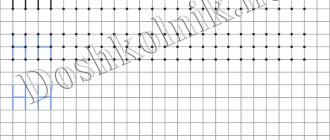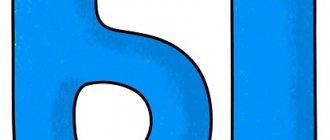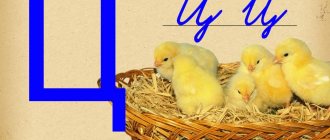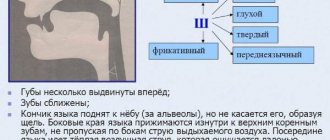SOUND AND LETTER “U” tasks for preschoolers
The work is carried out with children of preschool age. Children become familiar with the visual image of the letter U, looking for similarities and differences. The next task is aimed at developing letter gnosis - searching for the letter U. On the second page, much attention is paid to the development of graphomotor skills: coloring maple leaves with the letter U, writing the letter, adding missing elements; search among snails for a learned letter.
Letter U for preschoolers
Tasks for preschoolers “Letter U”
Letter U, copybooks, tasks
The children write the letter U in the boxes, and then find objects whose names begin with the sound U and color or trace them. This is a platypus, a fishing rod, an iron, a snail.
The letter U in pictures for preschool children.
Source: O.V. Uzorova, E.A. Nefyodova “Tables for teaching reading”
Author: I.I. Pilat, V.A. Knysh “LEARNING LETTERS BY PLAYING”
Activities with the letter U for the little ones
- Development of fine motor skills - shading snails, writing the letter U.
- Reading syllables with the vowel U.
- Completing words (letter U only).
- Painting parts of the mosaic with the letter U.
Letter U cursive for preschoolers
Tasks for preschoolers with the letter U
This manual is intended for parents who want to prepare their child for school on their own.
Letter U for children
Letter U for preschoolers
Primer with the letter U
Copybook with block letter U
Letter classes with speech therapists and speech pathologists
for preschoolers
1. Look at the picture. What sound does the boy make? How did you guess? What (who) else can make such a sound?
2. When pronouncing a sound, a small circle is drawn near the lip. Fill the small circle with red. We prepare children for the color designation of vowel sounds.
3. Trace the large and small letter Y with a pencil along the dots. Write down the lines of the letters U. Underline the letter U in the row of vowels (development of attention and visual perception).
4. Look at pictures of airplanes. Which plane do you think flies closest to you? Which one is further from you? Why did you decide so?
5. Guess which aircraft's drone sounds loud, like this. (The speech therapist pronounces the sound U in a loud voice. Children: “Big plane.”)
And what plane's drone sounds quiet?
(The speech therapist pronounces the sound U in a quiet voice. Children: “Small airplane.”)
How did you guess?
6. Now sing the big airplane song yourself; small plane. (The speech therapist makes sure that when pointing to the corresponding picture and pronouncing the sound U, the children change the strength of their voice.)
The speech therapist invites one of the children to make a guess, and the rest of the children to guess which aircraft is humming. (The child pronounces the sound U, changing the strength of his voice, the children point to the corresponding plane.)
7. Now take a pencil. Draw your pencil along the paths and sing airplane songs. (The speech therapist makes sure that the children pronounce the sound U on one exhalation and with different voice strengths.)
Letter U, development of phonemic perception
Letter U, tasks for speech therapists
Compiled by: Koptik S.A. “Workbook of speech therapy classes for 1st grade students”
- Introducing children to the letter U.
- Isolating the first sound in the words “duck”, “iron”.
- Determination of articulation when pronouncing the sound U.
- Writing the letter U in the air on a piece of paper.
- Primary work on distinguishing letters from sounds.
- Development of phonemic hearing - highlighting the vowel u in words.
- Spatial orientation - left-right.
- Working on fine motor skills.
Letter y for preschool children
Tasks with the letter U
Topic of the lesson: sound u (first lesson).
⇐ PreviousPage 3 of 25Next ⇒Purpose of the lesson: clear pronunciation of the sound
;
comparison of the sound y
with the vowels
a, ы, and
;
isolating the sound y
from a series of vowels and from the beginning of a word;
getting to know the letter y
.
Approximate course of the lesson
Organizing time.
The speech therapist enters the room, the children stand up. Then the speech therapist says: “Everyone got up well, quietly, and now I’ll tell you who can sit down (instructions are given in a low voice - children must be as attentive as possible to avoid mistakes). Sasha, sit down, Anton, sit down. Maxim, sit down. All the boys in the front row, sit down. All girls, sit down." And so on.
II. Setting the goal of the lesson.
The speech therapist says: “Today you will learn to pronounce sounds well .
and get acquainted with the letter
y
.”
III. Pronouncing a sound
.
u very clearly
quietly and with a voice of normal volume.
Using their mirrors, children examine the articulation of sound, learn that the sound y
is a vowel - it is pronounced freely, it can be drawn out, sung.
2. Then children practice pronouncing reverse and forward syllables, consisting of hard consonant sounds and the sound u
, i.e.
ut, mind, uk;
tu, mu, well , etc.
IV. Sound release
by ear from a series of vowels (played as a game “Who is the most attentive”).
1. The speech therapist pronounces vowel sounds, alternating them incorrectly ( a, u, s, u, i, a, u
etc.).
The instructions are given as follows: “You must raise your hand (or clap your hands) if I say the sound y
.” The exercise is carried out first without a screen, and then, in order to develop auditory perception, with a screen (or children are asked to close their eyes).
2. A similar exercise is carried out while walking.
Children walk around the room. The speech therapist pronounces different vowel sounds. To the sound of
everyone stops. The exercise is repeated 4 – 5 times.
V. Pronunciation of words with the sound u
.
Isolating the sound y
from the beginning of a word.
1. Children are asked to say the word duck
;
their attention is drawn to the fact that the first sound in this word is y
.
The speech therapist says: “Listen to what I say and look at my lips.” duck two or three times
, highlighting the intonation sound
u
.
Then the speech therapist continues: “In this word, the first sound is y
.
Let’s say this word again all together.” Similarly, the sound y
stands out from 2 - 3 more words (
ear, Ulya, snail
).
This time the children are asked to identify the sound y
from the beginning of the word themselves.
2. Pronunciation of the words spider, fly, fluff, shoes
, i.e.
with a y
in the middle of a word.
The speech therapist pronounces words clearly; tells the children that these words also have the sound u
, and then invites them to pronounce the words just as clearly (FOOTNOTE: Here and in the future, depending on the children’s capabilities, other words may be included in the lessons. So, for example, in this lesson it can be the words
oak, letters, soup, bag,
etc.).
VI. Introducing the letter u
.
Children are given cash registers containing the letter y
.
Then the purpose of the cash registers is explained to them (the letters in the cash registers are arranged in alphabetical order, and the cash registers are filled with letters gradually). Children look at the letters and write them in their notebooks. The letter in
the large format is red and is included in the table of vowels.
Second lesson on the sound u.
The material gets a little more complicated.
At the beginning of the lesson, children are asked what sound and what letter they learned the day before. Then the speech therapist invites the children to sit down after each of them clearly repeats the syllable pronounced by the speech therapist. Example syllables: tu, uk, um, mu
and with other consonants.
The lesson may include approximately the following exercises.
Repeating, following the speech therapist, combinations of two or three syllables such as: mu - tu; ut – uk
and so on. This exercise is conducted as an attention game. After two or three children repeat the proposed syllable series, a new combination is given. A very clear pronunciation of every syllable, every sound is constantly required.
Repeated pronunciation of words with the sound y
.
sound is repeated
from a series of vowels.
This time the children, upon hearing the sound, raise the letter y
.
a sound at the beginning of the words they pronounce.
;
if there is, then you need to raise the letter y
.
Since children do not repeat words, they can be of any sound composition ( street, iron, duckling, ears
, etc.).
For comparison, you can include several words that begin with the sound and
, as the most different from the sound
u
(
willow, Ivan, games).
Physical education minute. Children get up and do several exercises - moving their arms up, to the sides, down. At the same time, they pronounce syllables with the sound u
.
Writing (repeatedly) the letter y
.
Development of attention (carried out as a game).
The speech therapist says: “Let's see if you can listen well. I will tell you something only once, and then the one I call must do it.”
Instructions for memorization are given something like this: “You need to go to the shelf with toys, take a large brown bear and put it on a small chair that stands near the window.” “You need to take three pictures, put one on the table, give the other to Misha, and keep the third for yourself.” And so on.
For the sound and letter a
The material is selected in approximately the same way as for the sound and letter
y
.
Following the lessons on sound a, a lesson is held during which both sounds and both letters learned are repeated once again.
Let us describe the approximate course of the lesson.
Topic of the lesson: sounds a and u.
Purpose of the lesson: repetition of sounds a
and
y
;
isolating the sounds a
and
u
from the beginning of a word;
analysis of combinations like ay
.
Approximate course of the lesson
I. Organization of children.
II. Repetition of sounds and letters
and
y
.
The speech therapist asks the question: “What sounds and letters did we learn in previous classes?” ( Ah, y.)
Children show the corresponding letters and say: sounds and letters
a
and
u
- vowels.
1. During repetition, the correct pronunciation of these sounds is reinforced. For this purpose, the speech therapist asks individual children or gives the task to pronounce sounds one by one
and
y
, clearly articulating them (one child says
a
, the next -
y
, then again
a
, etc.).
2. Correlating articulation with sound. The instructions are given something like this: “Look at me and guess what sound I want to say.” The speech therapist (or one of the children) silently articulates. Children name the corresponding sounds, articulating very clearly. In addition to individual sounds for “guessing”, combinations of two sounds are offered - ay, ua
.
Children pronounce sounds or combinations, after which their attention is drawn to the number and sequence of sounds. So, for example, having articulated the combination ay
, the speech therapist offers to pronounce it to one of the children, and then asks the following questions: “How many sounds did you say in total?” (Two.) “What is the first sound?” (A.) “And the second one?” (U.)
III. Isolating the initial vowel from a word.
The speech therapist names words starting with the sound a
or to the sound
u
(
stork, street, lesson, pharmacy, orange, student, dinner, aster, bus,
etc.).
In this case, words of any sound composition can be selected, since children do not pronounce them. In each case, children must name only the first sound, i.e. a
or
y
, and raise the corresponding letter.
IV. Pronouncing words starting with the sounds a
and
y
.
There are pictures on the table. The called child takes one of the pictures, clearly pronounces the name of the object depicted on it, then names the first sound. Example words: Alik, Anya, duck, album, street, car, ear, antenna
and so on. All children are tasked with carefully monitoring the correct answers of their comrades.
⇐ Previous3Next ⇒
Live by the rule: IS THERE NOT MUCH THING IN THE WORLD EXISTING? It is no coincidence that I emphasize that the space in your head is limited, but there is a lot of information around, and that your right...
What makes your dreams come true? One hundred percent, unshakable confidence in your...
System of Protected Areas in the USA The study of specially protected natural areas (SPNA) in the USA is of particular interest for many reasons...
WHAT AND HOW THEY WRITTEN ABOUT FASHION IN MAGAZINES AT THE BEGINNING OF THE XX CENTURY The first issue of the Apollo magazine for 1909 began, in fact, with a policy statement from the magazine’s editors...
Didn't find what you were looking for? Use Google search on the site:
for 1st grade students (speech therapists, speech pathologists)
This manual contains many tasks for sound-letter analysis of words, which is very important when working with children with special needs development disorders. Attention is paid to the development of mental functions - memory, attention, perception, speech. An interesting and challenging task for children is the LABYRINTH WITH THE LETTER Y task.
Assignments with the letter U 1st grade
Tasks with the letter U
Logical tasks with the letter U
Labyrinth letter U
Labyrinth letter U
Study Materials
Poetry
* * * The letter “U” resembles the ears of a bunny on the top of its head. The snail's horns also look like the letter "U".
Poems about the letter "U"
Puzzles
* * * If I make sponges with a very thin tube, then pronounce the sound, then I will hear the letter...
Riddles about the letter "U"
Tongue Twisters
* * * The letter U is preparing dinner, The letter needs it for dinner. If you invite snakes, Dinner will be more fun.
Tongue twisters starting with the letter "U"
Fairy tales
Lessons “Sound and letter U” for 1st grade students
A whole sheet of copybook for large and small, printed and capital letters U. At the bottom of the page, a task for the development of visual perception and attention is to search for the letter U among the letter series. On the second page there is a similar task, but with more complexity - searching for the words ay, ua.
Letter U cursive for 1st grade
Letter U for 1st grade
Copybooks with the letter U
Copybooks and coloring pages with the letter U at the same time, and also good material for developing speech on the topics: “Insects”, “Plants”, “Riddles”.
Letter U, cursive (speech development)
Copywriting with the letter U (plants)
Copybook with letter U (animals)
Copybook "Letter U"
Writing the capital letter U
Lowercase letter U
Additional tasks with the letter U
These activities can be used with both first graders and preschoolers. Coloring pages with words that contain the sound U. And a very interesting and favorite coloring book with the letter U, where you need to find hidden letters.
Author of the manual: Kosenko Yu. A. “Learning to read and write”
Determine the place of the sound U in the word
Letter U coloring book. Find words starting with the letter U
Find all the letters U
Development of graphomotor skills
Coloring page with the letter U and writing the printed letter. Determining the place of the sound U in a word.
Coloring book with the letter U
Live sounds and letters in pictures
| Tasks with the letter A | Tasks with the letter Y | Tasks with the letter M |
| Learning the letter "B" | Learning the letter "B" | Learning the letter b, b |
| Tasks with the letter O | Tasks with the letter I, Y |







